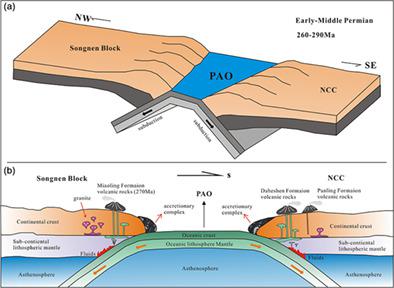当前位置:
X-MOL 学术
›
Geolog. J.
›
论文详情
Our official English website, www.x-mol.net, welcomes your
feedback! (Note: you will need to create a separate account there.)
Geodynamic setting of the south‐east margin of Xing'an–Mongolian Orogenic Belt: Constraints from geochronology and geochemistry of the Permian volcanic rocks in Yanbian area, NE China
Geological Journal ( IF 1.4 ) Pub Date : 2020-09-23 , DOI: 10.1002/gj.4001 Henan Hou 1 , Yunsheng Ren 1, 2 , Siyu Lu 1 , Yujie Hao 1, 3 , Qun Yang 1
Geological Journal ( IF 1.4 ) Pub Date : 2020-09-23 , DOI: 10.1002/gj.4001 Henan Hou 1 , Yunsheng Ren 1, 2 , Siyu Lu 1 , Yujie Hao 1, 3 , Qun Yang 1
Affiliation

|
The south‐east margin of the Xing'an–Mongolian Orogenic Belt (SM‐XMOB) is a tectonic junction that is characterized by widespread Late Palaeozoic to Early Mesozoic igneous rocks. To determine the tectonic settings and provide new constraints on the regional tectonic evolution, petrological, geochronological, geochemical, and Hf isotope analyses have been conducted on the Permian volcanic rocks along the SM‐XMOB. Zircon U–Pb geochronological data indicate that these rocks were formed at 271.4 ± 3.2 Ma and 268.3 ± 3.2 Ma during the Early–Middle Permian. Geochemical results suggest that the volcanic rock samples have 61.5–66.4 wt% SiO2 and 0.98–1.71 wt% MgO, and belong to the calc‐alkaline series, suggesting an affinity with fractionated I‐type granite. They also exhibit positive zircon εHf (t) values ranging from + 8.6 to + 14.7, indicating that the primary magmas were dominantly derived from partial melting of Early Palaeozoic juvenile lower crustal. These volcanic rocks show an enrichment in large‐ion lithophile elements (LILEs; e.g., Rb, Th, and U) and depletion in high‐field‐strength elements (HFSEs; e.g., Nb, Ta, Ti, and P), similar to that from an active continental margin setting. We therefore propose that the widespread Permian volcanic rocks in the SM‐XMOB were closely associated with the southward subduction of the Palaeo‐Asian Ocean (PAO) Plate to the lithosphere beneath the XMOB, and that the PAO had not closed prior to the Middle Permian in the SM‐XMOB.
中文翻译:

兴安-蒙古造山带东南缘的地球动力学背景:延边地区二叠纪火山岩的地质年代学和地球化学的限制
兴安-蒙古造山带(SM-XMOB)的东南缘是一个构造交界处,其特征是晚古生代至早中生代火成岩。为了确定构造背景并为区域构造演化提供新的限制,已经对沿SM-XMOB的二叠纪火山岩进行了岩石学,年代学,地球化学和Hf同位素分析。锆石U–Pb年代学数据表明,这些岩石是在早中二叠世形成的,分别为271.4±3.2 Ma和268.3±3.2 Ma。地球化学结果表明,火山岩样品具有61.5–66.4 wt%的SiO 2和0.98–1.71 wt%的MgO,属于钙碱系列,表明与分馏I型花岗岩具有亲和力。它们还表现出正锆石εHf (t)值介于+ 8.6至+ 14.7之间,表明主要岩浆主要来自早古生代下地壳的部分融化。这些火山岩显示出富含大离子的亲石元素(LILE;例如,Rb,Th和U)的富集,以及高场强元素(HFSE;例如,Nb,Ta,Ti和P)的耗竭,类似于来自活跃的大陆边缘设置。因此,我们建议SM-XMOB中广泛分布的二叠纪火山岩与古亚洲洋板块向南俯冲到XMOB下方的岩石圈密切相关,并且PAO在中二叠纪之前没有关闭在SM‐XMOB中。
更新日期:2020-09-23
中文翻译:

兴安-蒙古造山带东南缘的地球动力学背景:延边地区二叠纪火山岩的地质年代学和地球化学的限制
兴安-蒙古造山带(SM-XMOB)的东南缘是一个构造交界处,其特征是晚古生代至早中生代火成岩。为了确定构造背景并为区域构造演化提供新的限制,已经对沿SM-XMOB的二叠纪火山岩进行了岩石学,年代学,地球化学和Hf同位素分析。锆石U–Pb年代学数据表明,这些岩石是在早中二叠世形成的,分别为271.4±3.2 Ma和268.3±3.2 Ma。地球化学结果表明,火山岩样品具有61.5–66.4 wt%的SiO 2和0.98–1.71 wt%的MgO,属于钙碱系列,表明与分馏I型花岗岩具有亲和力。它们还表现出正锆石εHf (t)值介于+ 8.6至+ 14.7之间,表明主要岩浆主要来自早古生代下地壳的部分融化。这些火山岩显示出富含大离子的亲石元素(LILE;例如,Rb,Th和U)的富集,以及高场强元素(HFSE;例如,Nb,Ta,Ti和P)的耗竭,类似于来自活跃的大陆边缘设置。因此,我们建议SM-XMOB中广泛分布的二叠纪火山岩与古亚洲洋板块向南俯冲到XMOB下方的岩石圈密切相关,并且PAO在中二叠纪之前没有关闭在SM‐XMOB中。










































 京公网安备 11010802027423号
京公网安备 11010802027423号